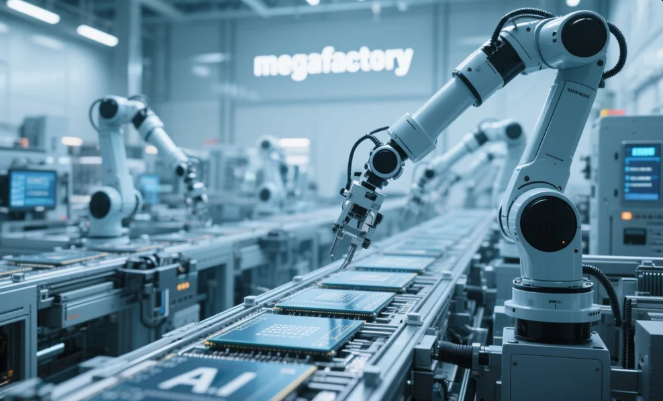Samsung Electronics and NVIDIA have announced plans to establish a next-generation AI Megafactory. This is a move set to reshape how semiconductors and advanced electronics are designed, produced, and optimized. The facility will deploy over 50,000 NVIDIA GPUs. It embeds AI across Samsung’s end-to-end manufacturing processes from chip design to equipment operations and quality control.
At its core, the AI Megafactory represents Samsung’s ambition to build a fully intelligent manufacturing network. Algorithms continuously analyze and optimize production in real time. The initiative goes beyond automation, merging vast datasets from chip fabrication, robotics, and system engineering into a self-learning ecosystem. This ecosystem adapts with every production cycle.

Lithography & Simulation Breakthroughs
The announcement extends a 25-year collaboration between the two tech giants. It begins with Samsung’s DRAM powering NVIDIA’s early graphics cards. Then it evolved into joint innovation in high-bandwidth memory [HBM4] and GPU-accelerated computing. Samsung’s HBM4 chips, built on a 10-nm-class DRAM with 4-nm logic base, deliver speeds of up to 11 Gbps. An emphasis on how memory advances are becoming pivotal to AI infrastructure performance.
The partnership also signals how semiconductor and AI development are converging. Samsung will use NVIDIA’s CUDA-X and cuLitho platforms to achieve a reported 20-fold improvement in computational lithography. This cuts design cycles and improving yield accuracy. In parallel, the companies are co-developing GPU-accelerated EDA tools and digital-twin simulations via NVIDIA Omniverse to enable predictive maintenance and real-time fab optimization.
For experts tracking industrial transformation, the deeper implication lies in how AI is becoming both the tool and the environment an active participant in manufacturing, not just a layer of analytics. Samsung plans to scale this AI Factory model globally, including to its Taylor, Texas facility, potentially setting new standards for intelligence-driven fabrication.
Beyond chips, the alliance reaches into robotics and AI-RAN [AI-powered radio networks], linking edge computing, connected devices, and physical AI systems such as drones and humanoid robots. The initiative cements Samsung’s pivot toward a future where the factory, network, and device form a unified AI ecosystem each learning, predicting, and improving in sync with the other






